Sapa is renowned for its picturesque and enchanting natural landscapes, offering numerous attractive tourist spots. Admiring the majestic nature, exploring the culture, and interacting with the people of Sapa will provide travelers with a journey full of fascinating experiences. Below is an in-depth introduction to Sapa to help visitors gain a better understanding of this tourist destination.
Table of Contents
Introduction to Sapa
Sapa is a highland district in Lao Cai province, located 38 kilometers from Lao Cai city, in the northwest mountainous region of Vietnam. Sapa covers a total area of approximately 678.6 square kilometers, characterized predominantly by hills and mountains. It is primarily inhabited by various ethnic groups, including the H’mong, Dao, Tay, Giay, Xa Pho, Kinh, and Hoa.
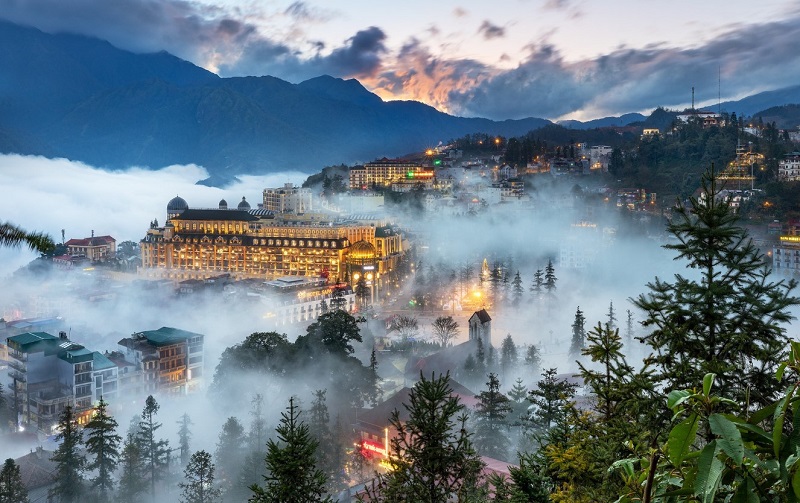
Sapa enjoys a temperate tropical monsoon climate. However, due to its elevation of 1,600 meters above sea level, the climate remains cool and pleasant year-round. The average annual temperature in Sapa ranges around 15 degrees Celsius. During the summer, the temperatures are quite mild, ranging from 13 to 15 degrees Celsius at night and 20 to 25 degrees Celsius during the day. In the winter, Sapa often experiences misty and chilly weather, with temperatures occasionally dropping below 0 degrees Celsius, leading to the occasional occurrence of snowfall. The average annual rainfall in Sapa is around 1,800 to 2,200 millimeters, mainly concentrated from May to August.
Origin of the Name “Sapa”
The name “Sapa” has its origins in the Quan Thoai language. Initially, the name in the Quan Thoai dialect for this area was “Sa Pả” (“Sa” means sand, “Pả” means beach). This sandy location was situated at kilometer 32 on the road from Lao Cai to Sapa. Before the establishment of the town of Sapa, this sandy area served as a gathering place for local residents and was known as the Sa Pả market.
During the French colonial period, the French pronounced “Sa Pả” without diacritics as “Sapa.” On administrative maps of that time, the place name “Sa Pả” was written in Latin script as “Chapa.” After 1945, the name “Sapa” was standardized in all administrative documents in Vietnam. However, some documents still accept the spelling “Sa Pa.”
Today, there is a neighborhood named “Sa Pả” located in the center of the town. This naming is intended to recall the original name of Sapa.
Why Sapa Became a Famous Tourist Destination
As one of the northern provinces of Vietnam, Sapa has experienced strong growth in tourism. It boasts clean, fresh air and a rich natural landscape, making Sapa one of the renowned tourist destinations. To learn more about the details, follow this article by Sinhtour to understand the reasons behind this.
Diverse Natural Landscapes
Located in the deep and remote mountainous region of Northwest Vietnam, Sapa is famous for its stunning terraced rice fields, deeply rooted in Vietnamese culture. Each season brings different surprises to tourists, from the water-filled terraces that resemble giant mirrors during the rainy season to the golden-hued rice terraces during the harvest season. The landscape of Sapa showcases both the natural beauty and the hard work of the local people who cultivate these fields in the mountainous terrain.

In addition to the terraced fields, Sapa also offers breathtaking views of the Hoàng Liên Sơn mountain range, with its towering peaks and the famous Fansipan summit, known as the “Roof of Indochina.” Most visitors to Sapa aspire to conquer Fansipan.
Experience Four Seasons in a Day in Sapa
Sapa is often compared to a miniature version of Da Lat in Vietnam. Visitors to Sapa can enjoy a refreshing climate similar to Da Lat’s. Sapa is located at an altitude of 1,650 meters above sea level, making it one of the most attractive tourist destinations in Vietnam.
You can experience the atmosphere of all four seasons in a single day. In the morning, it feels like spring with a slight chill from the cool night breeze or the lingering mist in the mountains. But as the sun rises higher in the sky, the morning chill gives way to the warmth of summer. By noon, when the sun is shining brightly, you’ll feel the heat of summer.
In the afternoon, as the sun begins to set and the temperature drops slightly, you’ll experience the coolness of autumn in Sapa. It’s advisable to wear a light jacket during this time. In the evening, when the night falls, Sapa offers a cold, mountainous climate, providing travelers with an intriguing and fascinating experience.
If you’re looking to escape the summer heat, don’t hesitate to visit the famous and captivating tourist destination of Sapa.
Diverse Tourism Products
Sapa is a tourist destination that attracts not only domestic but also international travelers. Here, you can enjoy various types of tourism activities, including leisure tourism, adventure tourism, and exploration.
Leisure tourism is a popular choice for those seeking a relaxing getaway. Thanks to its clean and refreshing air, Sapa is an ideal place for relaxation and rejuvenation. During your extended vacation, don’t forget to visit Sapa to explore and fully experience the beauty of the area.

In addition to leisure tourism, adventure and exploration tourism are also popular in Sapa. The Northwestern region is well-known for its ethnic villages, making it a great place for explorers. Many foreign travelers choose trekking to explore and immerse themselves in the local culture. They delve deep into the local villages to discover the unique beauty of the region.
Sapa is also famous for the Hoàng Liên Sơn mountain range, including Fansipan. It’s a destination for those who enjoy trekking and exploring the stunning natural landscapes of the area.
Ethnic Groups in Sapa
Currently, Sapa is predominantly inhabited by ethnic groups such as the H’mong, Dao, Tay, Giay, Xa Pho, Kinh, and Hoa. Among these, the H’mong ethnic group comprises more than 50% of the population in Sapa.
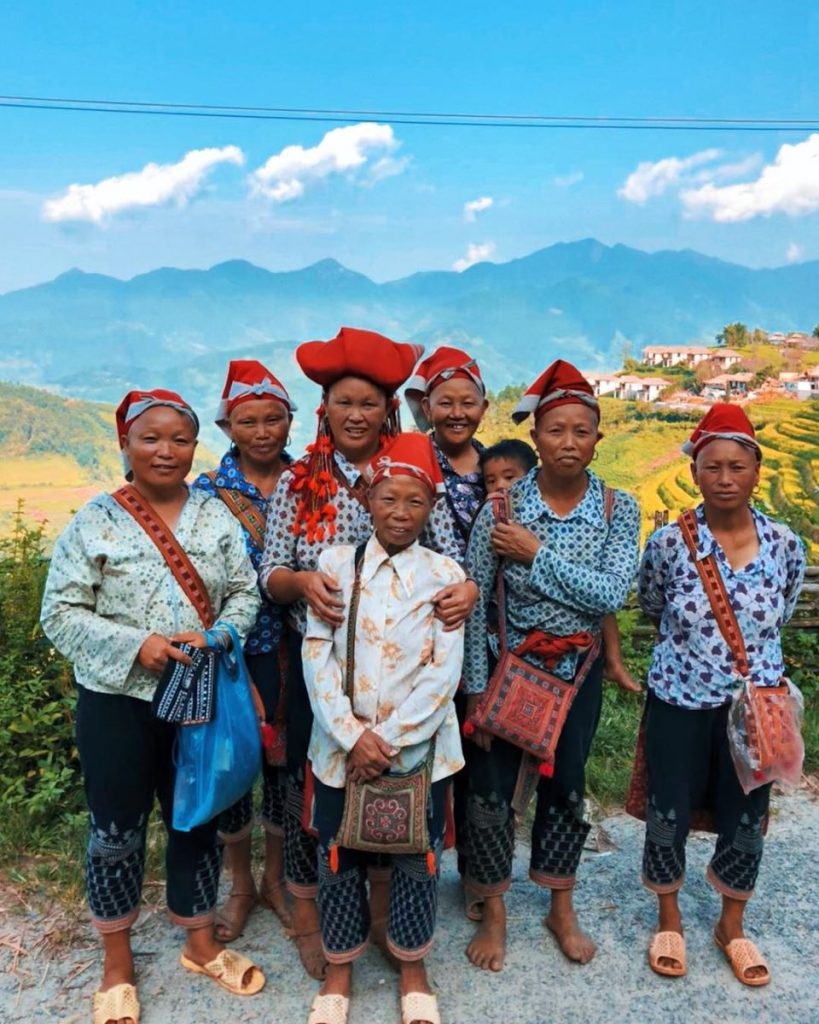
How Many Villages Does Sapa Have?
Sapa’s communal life is primarily organized around various villages, with seven villages developed into community-based tourism areas, including Cát Cát, Tả Phìn, Lao Chải, Tả Van, Sín Chải, Hồ, and Ý Linh Hồ.
Does Sapa Have Snow? When Does It Snow?
Sapa is one of the most beautiful places in Vietnam to witness snowfall. Snowfall typically occurs from December to January when strong monsoon winds lower temperatures in some areas of Sapa to below 0 degrees Celsius. Each snowfall in Sapa typically lasts for only 1 to 2 days.
How to Travel to Sapa?
By Bus from Hanoi to Sapa
Among the various transportation options to Sapa, taking a bus is a popular choice for many travelers. There are various bus options available today for the Hanoi to Sapa route. These buses offer modern interiors and amenities, providing passengers with a comfortable journey.
Typically, the travel time from Hanoi to Sapa by bus takes around 5 to 7 hours, depending on traffic conditions. However, if you choose to travel by smaller limousine buses, the journey can be as short as 4 hours. Larger sleeper buses may take between 5 to 7 hours.
Some popular bus lines from Hanoi to Sapa Lao Cai today:
| Double bed to Sapa:King Express Bus, Kadham Bus, The Anh | Price: From 650,000 to 700,000 VND/ticket |
| Limousine bed room from Hanoi to Sapa:G8 Open Tour, Ha Son, Phong Khanh, Sao Viet, Sapa Explore, Sapa Dragon Express, Sapa Express, Sapa Group Bus, The Anh | Price: From 310,000 to 750,000 VND/ticket |
| Limousine 9 – 13 seats Sapa:Daily Limousine, Dream Transport, Phúc Lâm Limousine, Eco Sapa Limousine, Luxury Van Limousine, Pumpkin Limousine, Sapa Express | Price: From 350,000 to 450,000 VND/ticket |
| Universal bed:Sao Viet, King Express Bus, The Anh, Phuc An, Hoang Anh – Lai Chau, Sapa Dragon Express, Ha Son (Ha Tinh), | Price: From 210,000 to 380,000 VND/ticket. |
Note: For international tourists, booking a double-decker bus can be somewhat challenging in Vietnam. You can make reservations through reputable online booking platforms. Additionally, when picking up passengers, you should pay attention to the timing because bus staff in Vietnam generally do not speak English, which can make the pick-up process difficult.
Private Car
Traveling by a private car from Hanoi To Sapa is suitable for larger groups, elderly travelers, and families with young children. It offers the most comfort and flexibility in terms of travel time. DanangPrivateCar.com’s is a leading provider of private car services in Hanoi, with professional drivers and years of experience, ensuring a safe and cost-effective journey.
By Plane
Traveling by plane is the most convenient option for travelers coming from distant locations, especially international or those from southern or central Vietnam. Since Lao Cai Airport is not officially operational yet, you’ll land at Noi Bai International Airport in Hanoi.
From there, you can take a bus directly to Sapa or choose to travel to Sapa by motorbike or train.

By Motorcycle
For adventurous travelers who enjoy exploration, traveling to Sapa by motorcycle is an excellent choice. It offers more autonomy and flexibility during your journey. However, motorcycle trips to Sapa require skilled riding and a thorough check of your motorcycle, as the journey can take approximately 10 to 12 hours from Hanoi to Sapa.
Due to the lengthy travel time, it’s advisable to start your trip early in the morning from Hanoi to arrive in Sapa on time. Alternatively, you can break up the journey into smaller segments, find overnight accommodations along the route, and continue to Sapa the following morning.
By Train from Hanoi to Sapa
Traveling by train is a suitable option if you want a unique experience. However, since there are no direct train services to Sapa, you’ll need to split your journey into two parts. First, take a train from Hanoi to Lao Cai Station. Then, continue the journey by taxi for about 35 kilometers to reach Sapa.
The average travel time for this mode of transportation is approximately 8 hours. Trains often depart at night, allowing you to make the most of your travel time by resting and recharging for your upcoming exploration of Sapa.
Train ticket prices from Hanoi to Sapa typically range from 250,000 VND to 1,800,000 VND per ticket.
Introduction to Famous Tourist Destinations in Sapa
Fansipan
Fansipan Mountain is located about 9 kilometers southwest of the center of Sa Pa town, within the territory of Son La province. Standing at 3,143 meters above sea level, Fansipan is known as the “Roof of Indochina.” From this elevation, tourists can fully admire the breathtaking scenery of Sapa from above, watch the drifting clouds, and witness the sunset at the highest peak in Southeast Asia. This is a special spot that every traveler visiting Sapa desires to explore and experience.
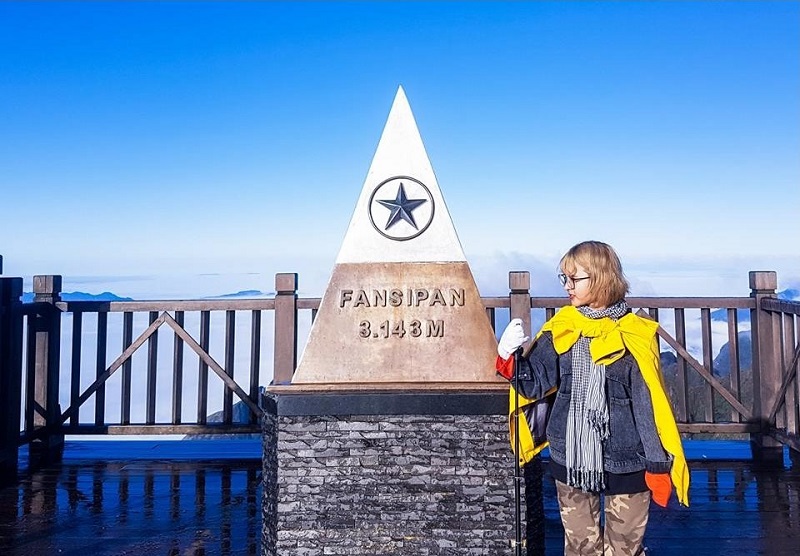
Ham Rong Mountain
Ham Rong Mountain is situated directly behind the stone church, at an altitude of 1,800 meters above sea level, and is part of the Hoang Lien Son mountain range. This location has been developed into an ecological tourism area, featuring three main sections: Ham Rong Flower Garden, Thach Lam Rock Garden, and Ham Rong Peak. When reaching the summit of Ham Rong Mountain, visitors have the opportunity to overlook the town of Sapa from above, hidden behind the mystical mist, and explore various miniature landscapes. Additionally, Ham Rong Mountain offers a cultural exchange area with traditional performances for visitors to enjoy and experience.
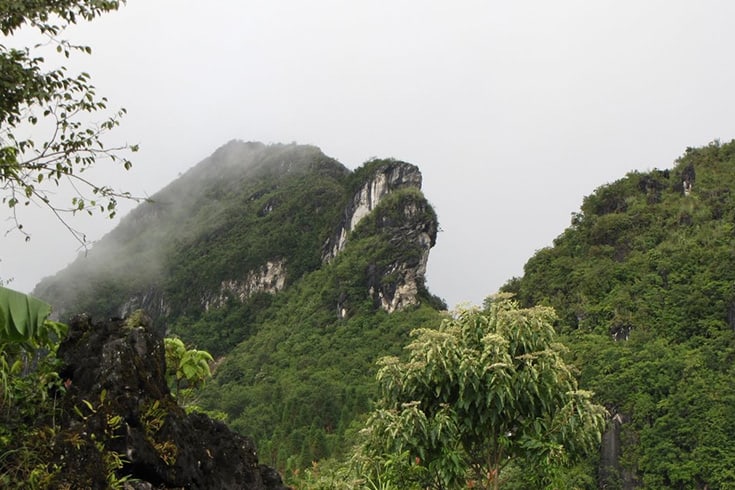
Stone Church Sapa
Sapa Stone Church is located next to the central square and covers an area of up to 6,000 square meters. The spacious church grounds, along with its unique architecture, are a major attraction for tourists to visit and explore. The intricate Gothic La-style architecture, popular in the French colonial period, is evident in the church’s decorative patterns and small carvings. Visitors can learn about the history and architecture of the church, take Instagram-worthy photos, or immerse themselves in the Sapa Love Market, which takes place on weekends at the church.

O Long Tea Hill
O Long Tea Hill is situated along National Highway 4D, on the way from Sa Pa town to Thac Bac (Silver Waterfall) and O Quy Ho Pass. Located about 7 kilometers northwest of the town center, O Long Tea Hill is a sought-after scenic spot for visitors to Sapa. The lush green tea bushes glisten with morning dewdrops under the sunlight, interspersed with cherry blossom trees. In late November, the cherry blossoms begin to bloom, painting the entire Sapa mountainous region in vibrant shades of pink and breathing life into the northwest mountains and forests.

Thac Bac Waterfall (Silver Waterfall)
Bac Waterfall is located approximately 12 kilometers from Sa Pa town, within the territory of San Sa Ho commune, Sapa district, Lao Cai province. The waterfall has a height of up to 200 meters, with cascading white foams resembling a glistening silver ribbon flowing down from the mountaintop. The best time to visit Thac Bac Waterfall is during the summer when water flows abundantly, creating a majestic and poetic spectacle. En route to Bac Waterfall, travelers will be captivated by the beautiful and picturesque scenery of the vast pine forest and the enchanting wild red rose blossoms covering the dreamy hills.
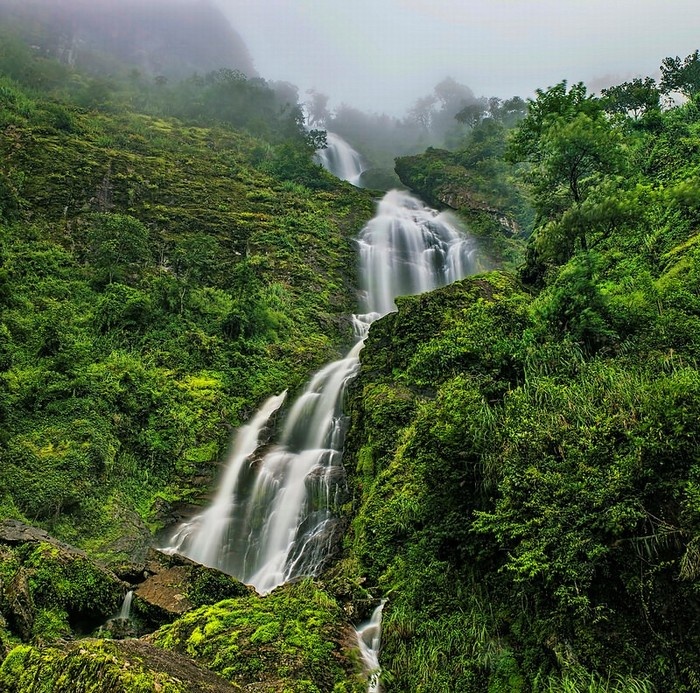
Cat Cat Village
Cat Cat Village is located in San Sa Ho commune, Sapa district, just about 2 kilometers from the town center. It is the home of the H’Mong ethnic community. When visiting Cat Cat Village, tourists can experience traditional craft villages, explore the unique culture of the H’Mong people through their dances, songs, and musical performances, and enjoy numerous picturesque spots for Instagram-worthy photos.

Lao Chai Village
Lao Chai Village is situated in the Muong Hoa Valley, about 7 kilometers from Sa Pa town. This area is one of the largest community-based tourism destinations in Sapa. When visiting Lao Chai, apart from experiencing the unique traditional culture, travelers can immerse themselves in the lively atmosphere of the highland weekend market, and marvel at the beauty of the magnificent terraced fields.

Sapa Love Market
The Sapa Love Market takes place every Saturday evening in front of the Sapa Stone Church square. This is a traditional love market, rich in the cultural heritage of the northwest mountainous people. Visitors to the market can not only admire the handicraft products displayed at the stalls but also immerse themselves in the world of music, dances, and melodious horn sounds, creating a vibrant and lively atmosphere.

Introduction to Sapa Cuisine
In addition to its stunning natural beauty and diverse culture, Sapa is also renowned for its unique cuisine. Some of the famous dishes that are popular among tourists when visiting Sapa include Thang Co (a type of hotpot), Men Men (a traditional H’Mong dish), salmon hotpot, colorful sticky rice (xoi mau), bamboo-tube rice (com lam), stolen pork (thit lon cap nach), grilled mountain fish (ca suoi nuong), and more. What makes the taste of Northwestern cuisine truly special is the distinctive spices made from ingredients like mac khen, cinnamon, star anise, and various herbs. These spices harmoniously blend together, creating the enticing flavors of Sapa cuisine.
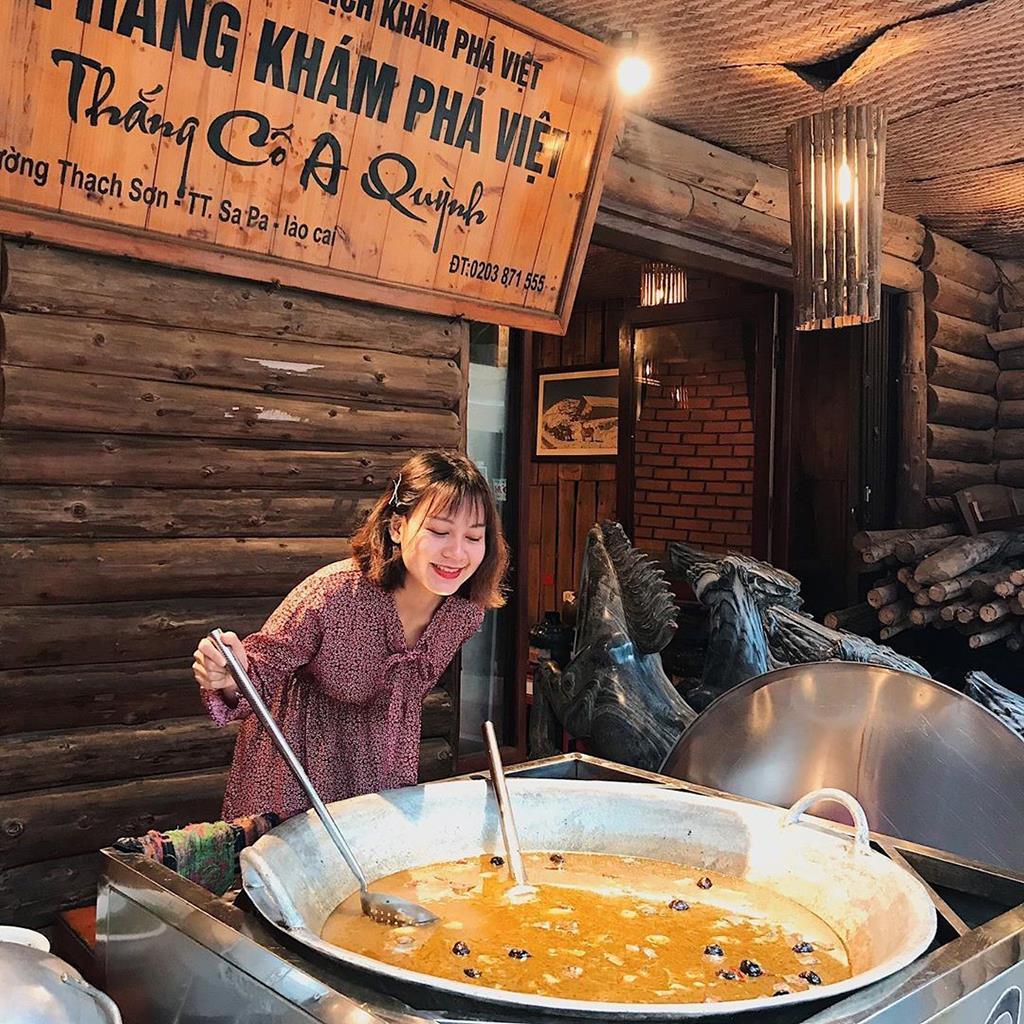
The article above has provided a comprehensive overview of the Sapa region. Hopefully, it has answered some of your questions and helped you gain a better understanding of this beautiful destination. Wishing you and your family a wonderful and complete journey when exploring Sapa!

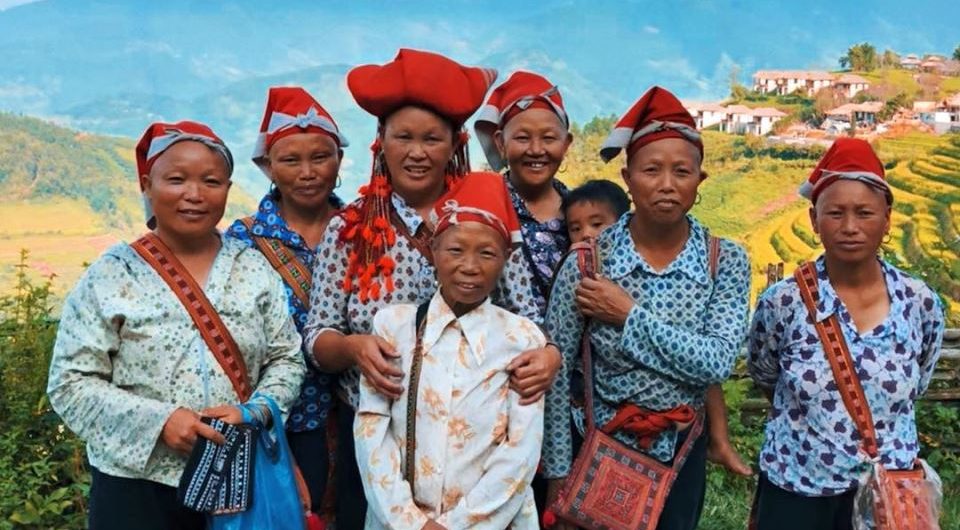
Comments